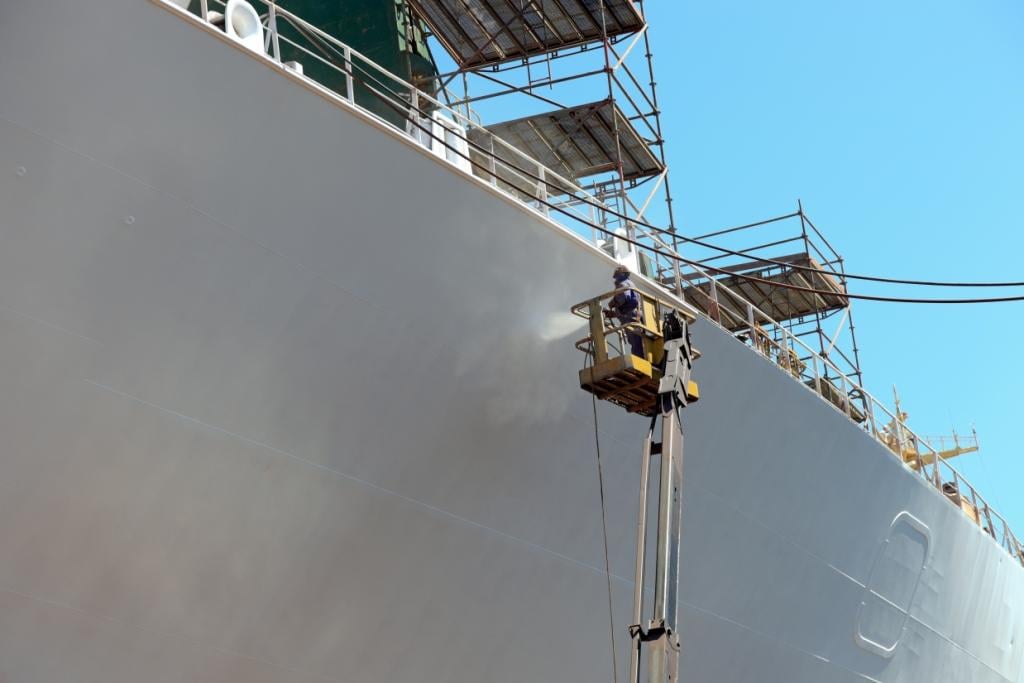While OSHA has set forth a comprehensive set of standards regarding fall protection, it remains one of the foremost ongoing concerns for the agency. All maritime facilities must have a clear approach to compliance, mandating safety procedures and strategies to keep employees safe.
The maritime industry has access to all the standards, procedures and guidelines from OSHA, and everyone wants to take measures to keep workers safe when working at heights. Maritime facility operators can take safety to the next level by developing a thoughtful and meaningful plan that makes everyone more attentive, engaged, and accountable. Using some basic philosophies and strategies can greatly improve your maritime facility safety and let your employees know their well-being is your priority.
Here are considerations for a solid 5-point fall protection plan.
1. Assess your facility to determine the high-fall risk areas
- Lack of—or poorly maintained—guard rails or barriers
- Inadequate, improper or no training for the use of personal protective equipment (PPE)
- Non-maintained ladders, scaffolding or catwalks
- Improper use of aerial lifts, forklift man-baskets or scissor lifts
- Unmarked height hazard zones that require special warnings
- Cliff stow cargo in the ship or in the terminal
- Any exposure to unguarded edges
2. Know the hierarchy of controls for fall protection
It is the preferred order of control to eliminate fall injuries. As the hierarchy progresses from 1 to 5, so does the risk of fall injury.
- Eliminate the Fall Hazard – use tools with long handles, lower the work, and preplan the job process to eliminate the need for workers to leave the ground level.
- Use Passive Fall Protection – install physical barriers like guardrails, protect foot-level openings with cages, cover manholes, and other proactive methods.
- Implement Fall Restraint Systems – use personal protective systems to restrict the worker’s range of movement so they cannot fall. There is training required using this approach.
- Require Fall Restraint Systems – use personal protective equipment to arrest a fall within acceptable force and clearance margins. Training and rescue planning are required with this approach.
- Practice Administrative Controls – this is the least preferred solution and is generally not recommended. It should only be used in specific cases where the other four approaches are not feasible. Practices or procedures increase the worker’s awareness of a fall hazard. Examples are caution tape to warn workers of an unprotected edge or spotters that warn workers of a fall hazard.
3. Focus on the degree of tolerance necessary when it comes to accomplishing tasks at heights
Workers should keep their feet planted on the ground whenever possible—even when using the best PPE available. The highest quality harness and self-retracting lanyards can’t undo one misstep or inadequate training—or the effects of suspension trauma—so it is always best to seek a safer option.
However, there are not always ground-based workarounds when employees need to work at elevations.
Still, it is highly recommended that risk assessments are performed for all work done at elevations, focusing on the level of risk tolerance necessary. It is important to continually search for ways to keep your employees as close to solid ground as possible.
4. Include your workers in the safety process
Your employees are in the best position to identify all exposure to fall hazards, so make sure they know you want them to voice all safety concerns, especially when working at elevations. Workers in the yard and on marine terminals have a good perspective and insight to identify and correct specific fall hazards.
Provide frequent technical training and educational sessions that teach the worker that working around unprotected edges is unacceptable. Ask them to pair their safety training with observations, such as whether a ladder is used improperly or a guardrail needs repair.
Remember that employees may feel worried that they are overstepping boundaries when reporting safety concerns, so reassure them that their insight is welcome and essential to keeping everyone safe.
5. Create a culture where there is full compliance with fall hazard safety
While it is important to include your employees in the incident prevention program, the employer is primarily responsible for the safety of its workers. Ensure employees know how serious non-compliance can be and that injury prevention is a key part of your culture.
Some workers may have taken risks at work previously and never suffered injury. Maybe they used a ladder improperly or worked at unprotected edges without negative consequences. If your culture truly discourages this at-risk behavior, workers will know it’s important to their boss and the company to work safely.
Make sure to frame your message in a positive light. Let them know you are glad they haven’t been injured and don’t want them to suffer from an easily prevented workplace injury.
Do you still need ideas for developing or improving your fall protection plan? For additional guidance on fall protection at your facility, contact your AEU Loss Control manager or click here to have someone contact you. ALMA members can access our fall protection materials resource library here (login required).
This article was originally published in the Longshore Insider on July 8, 2019.
SOURCES:
- The American Equity Underwriters, Inc. (2018). Fall Protection: The Greatest Challenge in Compliance & Risk Webinar [webinar].
- Safety and Health Topics - Fall Protection. Retrieved from https://www.osha.gov/SLTC/fallprotection/index.html.
- Safety and Health Topics – Personal Protective Equipment. Retrieved from
https://www.osha.gov/SLTC/personalprotectiveequipment/. - Lane, S. (2017, January 01). Suspension Trauma. Retrieved from https://ohsonline.com/Articles/2017/01/01/Suspension-Trauma.aspx.


